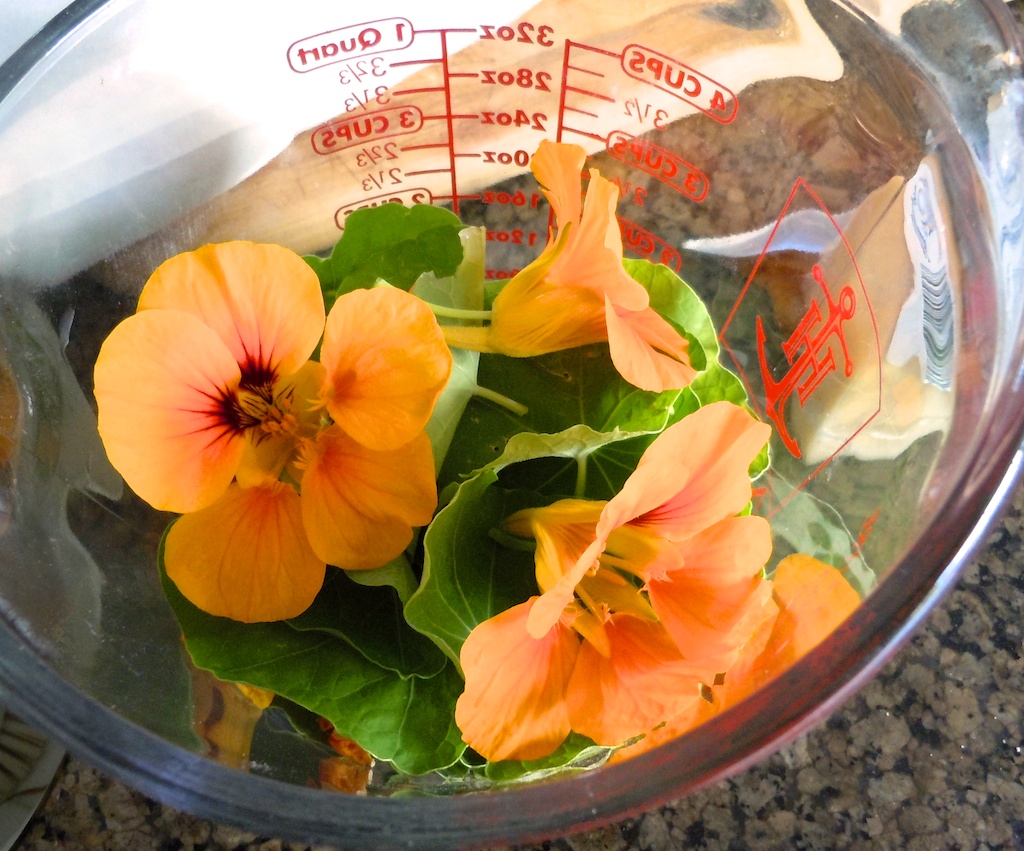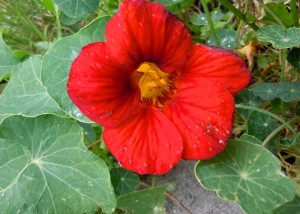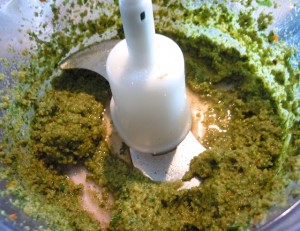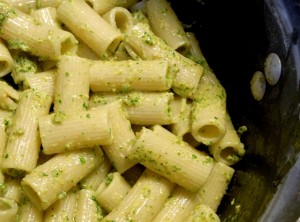 I first learned of nasturtiums several years ago when they were included in a planned herb garden kit. The seeds were large and legume-like, similar — to me, at least — to garbanzo beans. I planted them, along with parsley, thyme, borage, sage, etc., having little to no idea of what to expect.
I first learned of nasturtiums several years ago when they were included in a planned herb garden kit. The seeds were large and legume-like, similar — to me, at least — to garbanzo beans. I planted them, along with parsley, thyme, borage, sage, etc., having little to no idea of what to expect.
 Years hence, I know nasturtiums to be not only lovely and colorful (in both leaf and flower), but decidedly hardy, everlasting,uncannily recurring and requiring almost no tending to — which is usually what makes the most successful plants in my yard. I’ve grown two different kinds — the brightly variegated leaves of Alaska nasturtiums are matched by their beautiful blooms of orange, yellow and red. They branch out in gangly vines that accommodate any plants around them. Empress of India nasturtiums have leaves of deep bluish-green and ruby red flowers. They are less prolific, but always a welcome sight.
Years hence, I know nasturtiums to be not only lovely and colorful (in both leaf and flower), but decidedly hardy, everlasting,uncannily recurring and requiring almost no tending to — which is usually what makes the most successful plants in my yard. I’ve grown two different kinds — the brightly variegated leaves of Alaska nasturtiums are matched by their beautiful blooms of orange, yellow and red. They branch out in gangly vines that accommodate any plants around them. Empress of India nasturtiums have leaves of deep bluish-green and ruby red flowers. They are less prolific, but always a welcome sight.
As if all those characteristics were not enough, nasturtiums are also edible! The leaves and flowers can be plucked and added to salads, lending a somewhat spicy (but not overly so) hit to your greens, similar to arugula.
A while back, my long time friend and collaborator discovered a recipe for nasturtium pesto. I was intrigued. The taste could be interesting, plus nasturtiums were plentiful right outside my door, whereas basil required a trip to the market.
So I looked at the referred recipe, as well as a few others. As sometimes happens, I liked elements of one recipe and then a touch from another. Recipe fusion has become commonplace in my kitchen – it can be risky, but usually rewarding. Life, after all, is one, hopefully long, experiment.

I have made pesto before — the traditional version of basil, pine nuts, garlic, olive oil and parmesan cheese. Pesto (coming from the Italian word “peste” meaning to pound or grind in reference to a mortar in pestle, the tools originally used to make the pasty sauce) is very simple, nearly foolproof if you have the proportions right (find a good recipe to get these), and is very versatile. It can be a beautiful coating for pasta, but also an accessory for chicken or fish, or a spread for toasted bread (bruschetta) or sandwiches.
To make a good pesto, you’ll need a blender or food processor. A Food Processoris recommended since a blender’s vertical dimension and the chunky nature of the ingredients require a bigger surface and blade to get everything chopped finely and evenly. Or you can go old-school and try the mortar and pestle (and hats off to you, if you do!).
 So for this pesto, I used nasturtium leaves and flowers (pretty!), cilantro and parsley leaves, garlic, walnuts (which can almost always substitute well for pine nuts), grated parmesan cheese, garlic, lemon juice and salt and pepper. These were first blended in the food processor, then with the machine running, olive oil was poured in.
So for this pesto, I used nasturtium leaves and flowers (pretty!), cilantro and parsley leaves, garlic, walnuts (which can almost always substitute well for pine nuts), grated parmesan cheese, garlic, lemon juice and salt and pepper. These were first blended in the food processor, then with the machine running, olive oil was poured in.
I chose rigatoni pasta (I’m a fan of both its shape and substantiality…I am always amazed at how pasta varies in taste based on shape even though it is made of the same elements) on which to serve my garden pesto. It carried it well. I was concerned that the nasturtiums would either taste too peppery or perhaps be too subtle. Neither concern was warranted. The flavor of the pesto was…very green, in the best way possible. I’d say grassy, but that’s not quite right. Softly spicy, bright and in no way overpowering, it was quite delicious as a cloak for the pasta and somewhat more appealing than a basil-based peso. I do love basil (as does my rabbit), but it tends to dominate anything it is a part of, which is great should that be your fancy. What was lovely about this pesto is that all the ingredients were on equal footing and could be savored fully. 
So now I’m even more of a nasturtium fan. And as I drool in anticipation of future pestos, I’m resisting the urge to hover over these independent plants (a surefire way to end their proliferation). Some plants, like some loves, flourish best with minimal tending.
Nasturtium Pesto
2 cups nasturtium leaves and flowers (about 8 to 10 flowers)
1/4 cup parsley
1/4 cup cilantro
1/2 cup walnuts
3/4 cup grated parmesan cheese
2 cloves peeled garlic
Juice of 1/2 lemon
Salt and pepper to taste
1/2 cup extra virgin olive oil
Combine all ingredients except olive oil in a food processor and pulse until evenly and finely chopped. With food processor running, pour olive oil through “feeding tube” of machine until fully incorporated. Serve on pasta, as a sauce for chicken or fish or a spread.
Blogger’s Note: This pesto recipe made enough for a sauce on rigatoni for two people. The leftover pesto was refrigerated in a covered dish and used the following evening spread on a slices of toasted baguette with mozzarella cheese melted on top.